The old folklore of the area records that this bridge was built by the Devil, and a story based on this folklore appeared in the Chronicles and Stories of the Craven Dales (Dixon, 1880).
The legend is set during the Middle Ages, sometime before the dissolution of the monasteries (1540), when Fountains Abbey was still a thriving religious community. A cobbler from the village of Thorpe (near Grassington) was returning home from the abbey with a bag of shoes for repair, when he found the river Dibb was in flood, and so he had to wade across. On the other side of the river he met a smartly dressed gentleman who asked him how far it was to Grassington. For some reason the cobbler was suspicious of the stranger and so he told him that it was a long way, and that he himself had worn out the bag of shoes travelling from there. The gentleman looked at the bag of different sized shoes, and raised an eyebrow,
but then asked the cobbler if he had anything to eat, as he was very hungry. This seemed to break the ice a little and the two sat down to a hearty meal washed down with fine wine from the abbey. The cobbler then admitted that Grassington was only 3 miles down the road, while to his great shock, the gentleman revealed that he was in fact the Devil, on his way to collect a tithe of souls from the district. However, because the cobbler had proved generous, and such good company, the Devil said he would turn aside and spare them his visit on this occasion. He also asked the cobbler if he would like anything in return for the food and wine he had provided, and the cobbler thinking of his earlier wading across the swollen river, asked if the Devil could build a bridge over the Dibb. The Devil agreed to this request, and a few days later a well built stone bridge appeared, spanning the river. The locals were amazed at the new bridge, but were afraid to use it when they heard that it had been built by the Devil. A priest was called in to bless the structure with holy water, and a cross was erected at each end of the bridge so that no evil would befall anyone who crossed over it.
Stories of bridges built by the Devil appear in other parts of
Britain and Europe. The Devil's usual fee for constructing the bridge is that
he can claim the first soul to cross over it, but he is usually tricked when a
dog is sent over first. In the Dibble's Bridge story, the Devil seems to have
been in a better mood after his boozy lunch, and builds the bridge for free,
showing that even the devil was not immune to the old 'Yorkshire bite'. It has
also been suggested that the idea that the Devil gets the first soul is a
memory of animal or human foundation sacrifices, made to appease the 'genius
loci' (spirit) of a site.
As noted in the Nursa Knott post, the Devil appears to have replaced an earlier giant or giantess figure in some old stories that were 'updated' during the Middle Ages. In myth and legend, giants were known for their building skills, the Anglo-Saxons thought that the ruins of large Roman buildings were the work of giants, while in medieval times, Stonehenge was believed to have been built by giants. In Norse myth, Odin employed a giant to build a great wall around Asgard - the citadel of the Norse gods. So these Devil/giant stories may have their roots in much older beliefs.
What's in a name
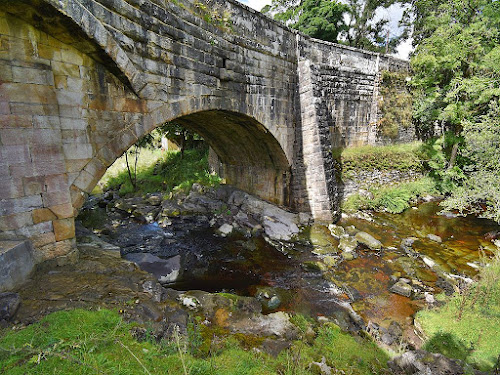 It would seem that at least locally, Dibble was a name used for the
Devil, either in the local dialect or as a kind of nickname so as not to
invoke his name directly. The river Dibb and perhaps Dibbdale (?) point to a
more logical origin of Dibble, and there are several 'Dybdal' placenames in
Denmark, meaning the 'Deep Valley'. This description would tally with the long
hill descending down to the bridge, and the steep sides to the valley further
down the dale.
It would seem that at least locally, Dibble was a name used for the
Devil, either in the local dialect or as a kind of nickname so as not to
invoke his name directly. The river Dibb and perhaps Dibbdale (?) point to a
more logical origin of Dibble, and there are several 'Dybdal' placenames in
Denmark, meaning the 'Deep Valley'. This description would tally with the long
hill descending down to the bridge, and the steep sides to the valley further
down the dale.
Whatever the origins of the name, the 'Divil' seems to have been quite active in this area, dropping a cairn of stones near Simon's Seat to the south, or tripping over Nursa Knott hill to the east, while trying to fill up Dibb Gill. His preoccupation with the Dibb Valley may be connected with the small settlement of Grimwith - now submerged beneath a reservoir at the head of Dibb valley. Grimwith means 'the ford of Grim', while Grim was also one of the nicknames given to the Norse god Odin. In later folklore the memory of Odin lived on where he was viewed as a giant or the Devil.
Today, the river Dibb could be described as more of a stream, due to its waters being held back by the Grimwith reservoir to the north. However, the size of the valley does suggest that a much larger river has flowed down the dale in the past, probably carrying flood waters from the higher moorlands. On the modern OS map the waters downstream from the Dibble's Bridge are called Barben Beck, but this seems to be a more recent naming, as the presence of 'Dib Side' and 'Dib Well' in this lower section suggests that this was once all regarded as Dibb Dale, and the whole watercourse from Grimwith to the River Wharfe was the river Dibb.
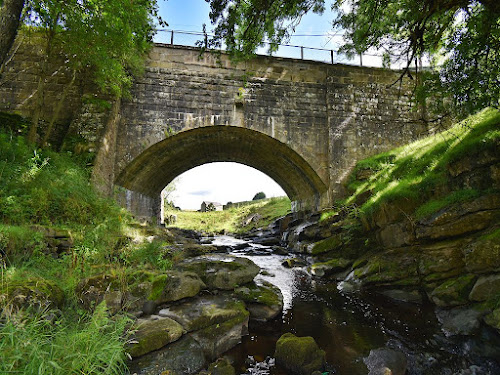 In more recent times the Dibble's Bridge has been tragically
associated with two separate road accidents in which coaches crashed over the
side of the bridge, killing more than 30 people. The cause of the accidents
seems to have been brake failure on the long steep hill leading down to the
bridge. It is perhaps sadly ironic that Dr. Dixon noted the two crosses
originally setup to protect people using the bridge were removed by a Puritan
minister, who objected to the display of such Christian symbols. Old local
tradition perhaps knew better, and felt that something about this location
required divine protection for those crossing the 'Devil's valley'. Even
during the mid 1800's, Dr. Dixon mentions that a ghostly figure could
sometimes be seen sitting on the bridge parapet at dusk. The time and location
are reminiscent of the Bean Sidhe (banshee) or 'Washer at the Ford' - a
supernatural female figure haunting bridges and river crossings. Her quiet
sobbing, or wailing cries were an omen of death, and she might also be seen
crouching by the water washing the clothes of those soon to die.
In more recent times the Dibble's Bridge has been tragically
associated with two separate road accidents in which coaches crashed over the
side of the bridge, killing more than 30 people. The cause of the accidents
seems to have been brake failure on the long steep hill leading down to the
bridge. It is perhaps sadly ironic that Dr. Dixon noted the two crosses
originally setup to protect people using the bridge were removed by a Puritan
minister, who objected to the display of such Christian symbols. Old local
tradition perhaps knew better, and felt that something about this location
required divine protection for those crossing the 'Devil's valley'. Even
during the mid 1800's, Dr. Dixon mentions that a ghostly figure could
sometimes be seen sitting on the bridge parapet at dusk. The time and location
are reminiscent of the Bean Sidhe (banshee) or 'Washer at the Ford' - a
supernatural female figure haunting bridges and river crossings. Her quiet
sobbing, or wailing cries were an omen of death, and she might also be seen
crouching by the water washing the clothes of those soon to die.
The local name and folklore mark this ancient river crossing (and perhaps the wider Dibb Gill valley) as a place of supernatural significance. The bridge was haunted by a ghostly figure at dusk, the devil himself was said to have constructing the bridge, while on another occasion a giantess (?) tried to dam up the river for reasons unknown. There was perhaps some connection with 'Grim's Ford' further up the valley, maybe recording an old association with Odin, or some of his followers who clung to the old religion in this isolated dale. Could they have been the original heathen 'devils', marking this as the devils valley?
One final point worth noting is that the foundations of the bridge are built on an exposed section of bedrock, through which the waters of the Dibb have worn a narrow channel over the years. In the past this would have provided a convenient point to ford the river on this ancient route to and from the Dales. The surface of the bedrock under the bridge has many fossil shells deeply embedded in it, and these appear to be of a type called Gryphaea, better known as the Devil's Toenail!

|
|
Looking down into Dibb Dale and Dibble's Bridge. |
After Thoughts
People were said to have received a
'Yorkshire Bite' when they drew the short straw in any dealings with a
Yorkshireman.
Was the Devil (or giant) at Nursa Knott part of an earlier
legend connected with this river crossing?
Dixon refers to the Devil as
the "Old Gentleman". A crag in Trollers Dale is called the Old Man's Scar.
References
Dixon, J.H. (1880)
Chronicles and Stories of the Craven Dales.

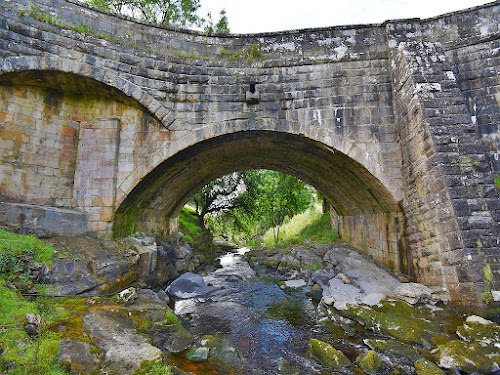
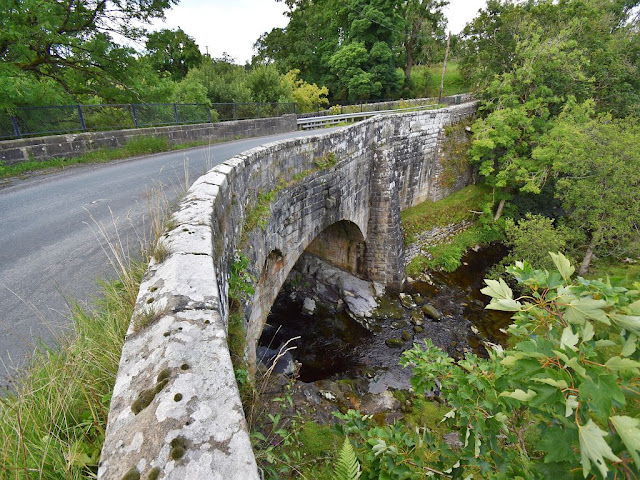
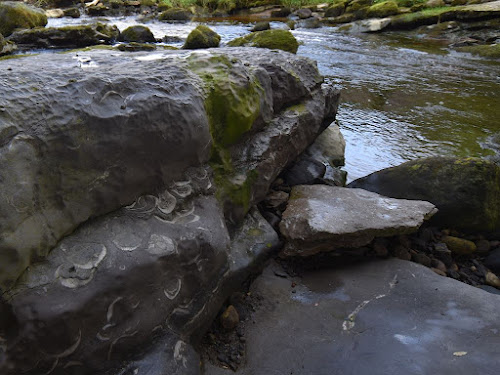
Being an angler I can't resist looking over a bridge. There must be many surrounded by myths and legends and now another point of view is developing. Many thanks, ATB, John
ReplyDeleteThanks for the comment, its true that so much local history and folklore was simply never recorded, and so it is now lost to us. I think we are culturally poorer as a result.
Delete